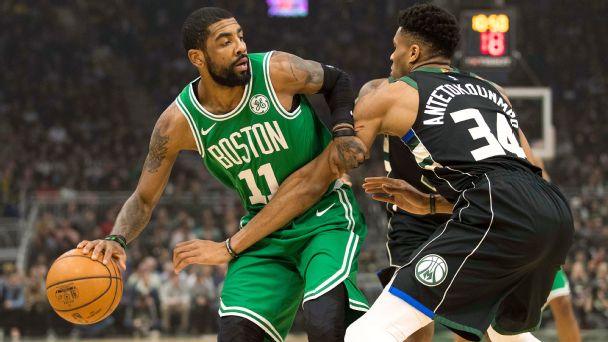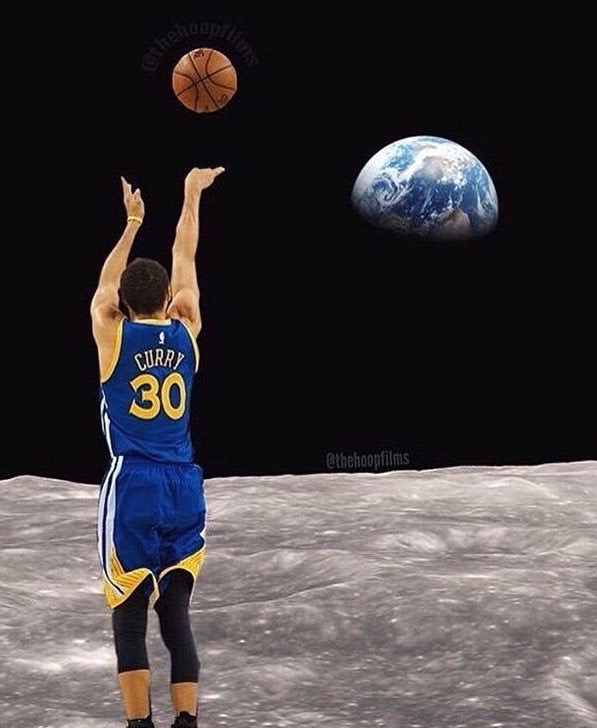
Lots of dumb ideas like legal goaltending on 3s and have teams make their own custom 3 point line
Editor's note: The following excerpt from the new book "SprawlBall: A Visual Tour of the New Era of the NBA," by ESPN NBA analyst Kirk Goldsberry, has been updated and edited for length and clarity.
As the second round of the NBA playoffs kicks into high gear, the most star-studded series features two unprecedented MVPs in James Harden and Stephen Curry. Both players leveraged the power of the 3-point shot more than any superstars in league history.
Consider these factoids:
- Prior to 2015-16, no NBA player had ever made 300 3-pointers in a single season. That season, Curry sank 402.
- At age 29, Harden is already the all-time leader in unassisted 3-point makes.

The data-driven line
Here's an interesting fact: An average NBA field goal attempt is worth almost exactly one point. What a magical analytical convenience! This one-point average is very helpful as we compare and contrast efficiency across teams and players, not to mention shot types.
NBA playoffs on ESPN/ABC[/paste:font]

It's playoff time. Don't miss these games.
Thursday (All times ET)
• Raptors at 76ers | 8 p.m. | ESPN
Friday
• Bucks at Celtics | 8 p.m. | ESPN
• Nuggets at Blazers | 10:30 p.m. | ESPN
Saturday
• Warriors at Rockets | 8:30 p.m. | ABC
Sunday
• Raptors at 76ers | 3:30 p.m. | ABC
But what if we used that baseline to optimize the placement of the 3-point line? What if the actual shooting and scoring abilities of NBA players informed the layout of the league's playing surface? For generations, the league has adjusted its playing surface as a way to make sure the game remains as entertaining and competitive as possible. In the so-called Moneyball era, when every team in the league has begun to leverage data to strategize, the league itself has opportunities to do the same thing.
The invention of the 3-point line made 33.33 percent a sort of magical number in NBA analyses. Anyone who can make a third of their 3s can turn 3-point shots into one point on average. It's the same as making half of your 2s. But as a generation of shooters has warmed up to long-range shooting, NBA shooters are making 36 percent of their triples, and specialists regularly convert over 40 percent of them. That's the same as making 60 percent of your 2s.
That slight increase in efficiency and the major increase in the population of players who can achieve that efficiency at high-volume levels are two defining drivers of the SprawlBall era.
For individual players, these efficiency upticks may seem small, but at the league level they're massive. When a whole population of shooters are sinking 36 percent of their 3s, the economic behaviors of shot selection at the population level completely change. There was a time when 3-point shots weren't the smartest jump shots on the floor for most shooters in the league. That time is gone now. Also, we now have data and analyses capable of mapping out with great precision where NBA shooters make and miss. These maps should inform how and where the league places its 3-point line.

It's a logical approach based on the guiding principle that shots get harder with distance (duh!) and field goal percentage decreases. Using contemporary shooting data, we can estimate where the line would have to be for the league to convert exactly one third of its 3-point attempts.
Consider the 2017-18 season. By studying league averages at different shot distances, we can hone in on where the league as a whole made about one-third of its 3s. As you can see here, the shortest 3s -- those short ones in the corners -- went in over 39 percent of the time:

But the graphic doesn't answer this key question: Where would the line have to be so that the cumulative set of NBA 3-point tries would go in 33.33 percent of the time? That's a hard question to answer, but by studying the nearly 70,000 non-heave 3-point tries from 2017-18, we can make an estimate. During the 2017-18 season, excluding heaves, NBA shooters made exactly 33.33 percent of their 3s from beyond 25.773 feet, a distance almost exactly two feet beyond the current line.
So why not place the line there?







 leave it the fukk alone!!!
leave it the fukk alone!!!